Global DNA methylation profiling reveals new insights into epigenetically deregulated protein coding and long noncoding RNAs in CLL
- PMID: 27777635
- PMCID: PMC5062931
- DOI: 10.1186/s13148-016-0274-6
Global DNA methylation profiling reveals new insights into epigenetically deregulated protein coding and long noncoding RNAs in CLL
Abstract
Background: Methyl-CpG-binding domain protein enriched genome-wide sequencing (MBD-Seq) is a robust and powerful method for analyzing methylated CpG-rich regions with complete genome-wide coverage. In chronic lymphocytic leukemia (CLL), the role of CpG methylated regions associated with transcribed long noncoding RNAs (lncRNA) and repetitive genomic elements are poorly understood. Based on MBD-Seq, we characterized the global methylation profile of high CpG-rich regions in different CLL prognostic subgroups based on IGHV mutational status.
Results: Our study identified 5800 hypermethylated and 12,570 hypomethylated CLL-specific differentially methylated genes (cllDMGs) compared to normal controls. From cllDMGs, 40 % of hypermethylated and 60 % of hypomethylated genes were mapped to noncoding RNAs. In addition, we found that the major repetitive elements such as short interspersed elements (SINE) and long interspersed elements (LINE) have a high percentage of cllDMRs (differentially methylated regions) in IGHV subgroups compared to normal controls. Finally, two novel lncRNAs (hypermethylated CRNDE and hypomethylated AC012065.7) were validated in an independent CLL sample cohort (48 samples) compared with 6 normal sorted B cell samples using quantitative pyrosequencing analysis. The methylation levels showed an inverse correlation to gene expression levels analyzed by real-time quantitative PCR. Notably, survival analysis revealed that hypermethylation of CRNDE and hypomethylation of AC012065.7 correlated with an inferior outcome.
Conclusions: Thus, our comprehensive methylation analysis by MBD-Seq provided novel hyper and hypomethylated long noncoding RNAs, repetitive elements, along with protein coding genes as potential epigenetic-based CLL-signature genes involved in disease pathogenesis and prognosis.
Keywords: Chronic lymphocytic leukemia; DNA methylation; Hyper/hypomethylated regions; Repetitive elements and noncoding RNAs.
Figures
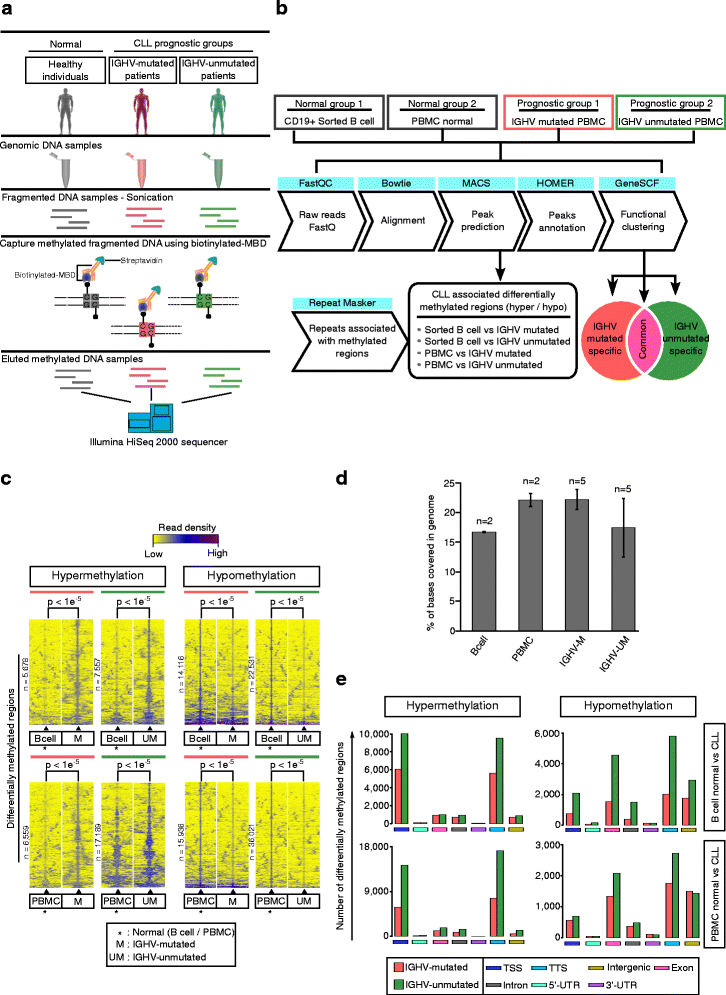
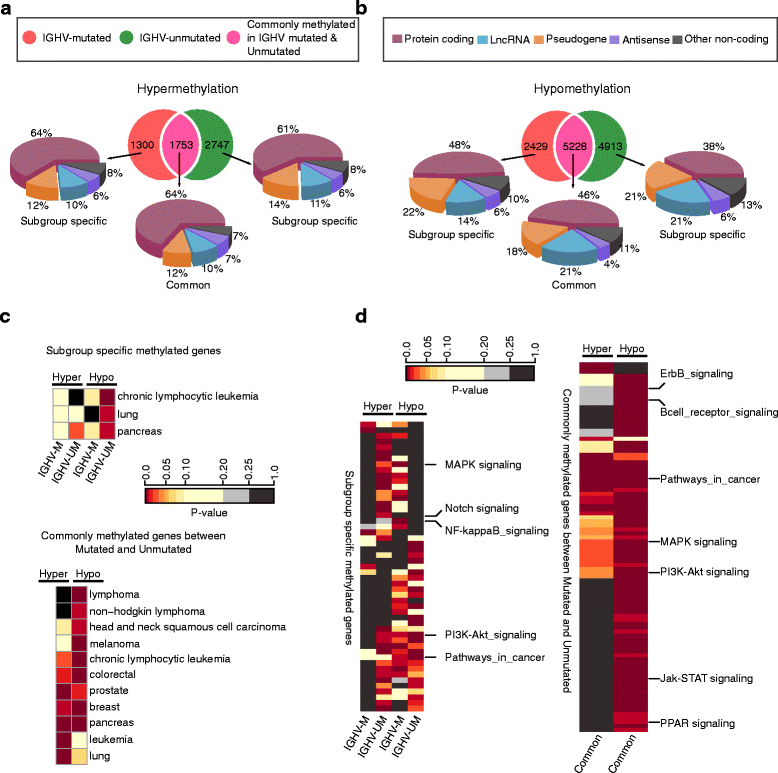
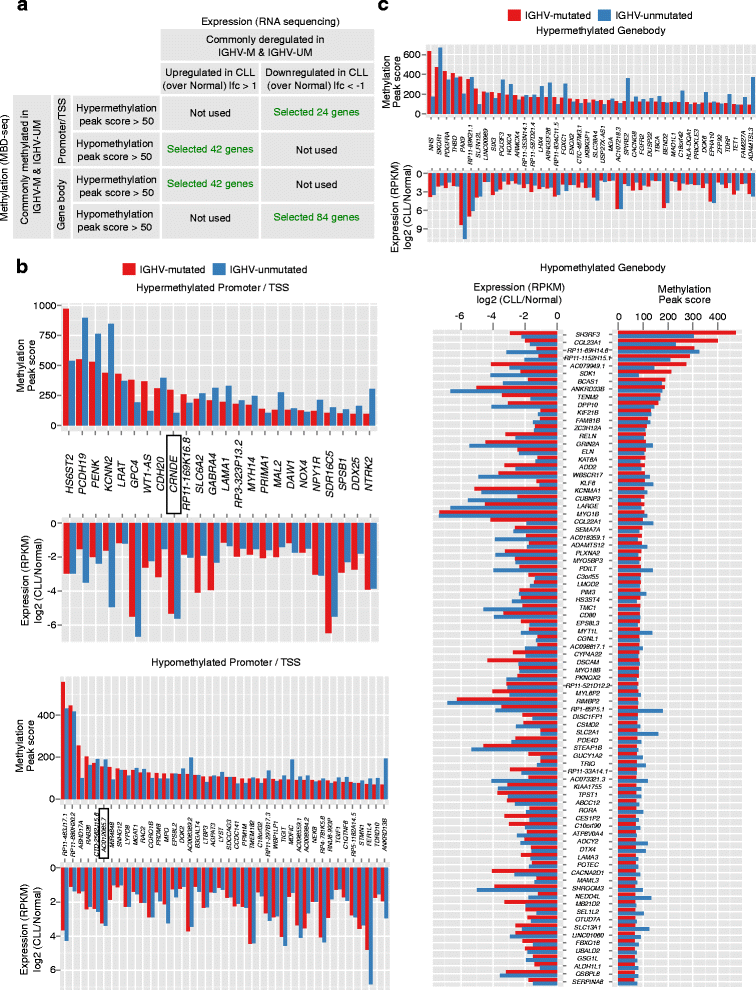
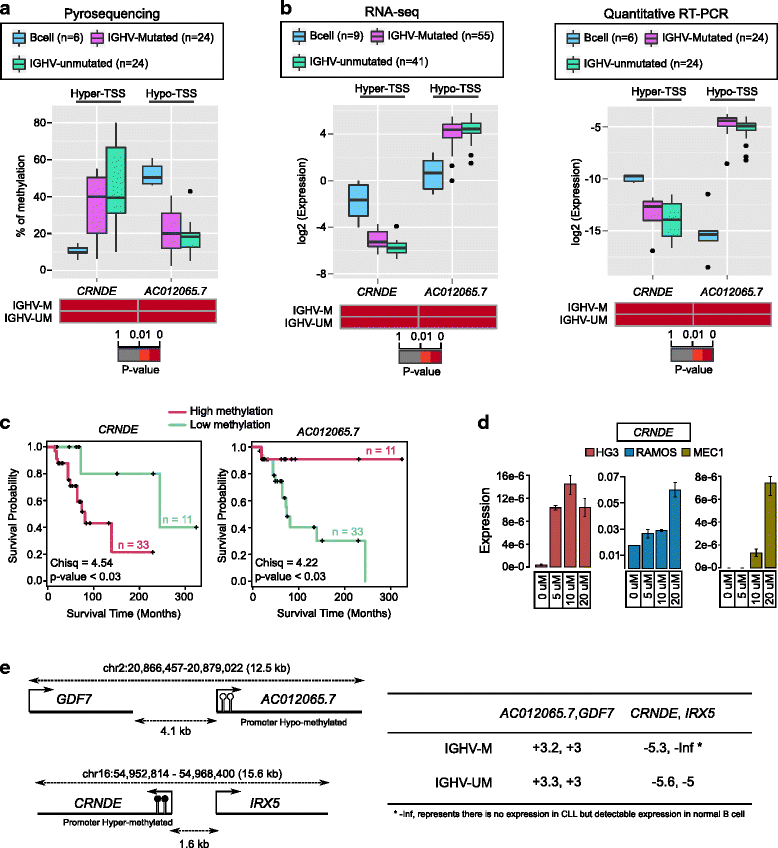
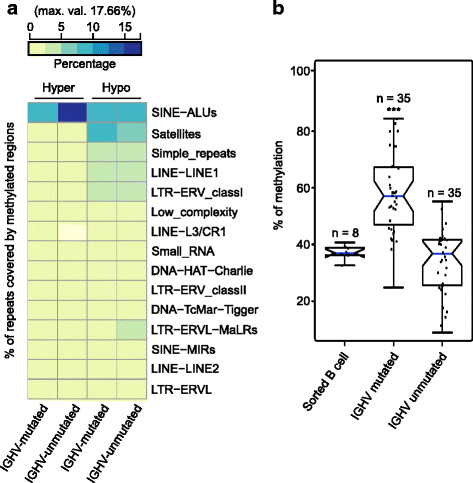
Similar articles
-
Comprehensive DNA Methylation Analysis Using a Methyl-CpG-binding Domain Capture-based Method in Chronic Lymphocytic Leukemia Patients.J Vis Exp. 2017 Jun 16;(124):55773. doi: 10.3791/55773. J Vis Exp. 2017. PMID: 28654059 Free PMC article.
-
Genome-wide DNA methylation profiling integrated with gene expression profiling identifies PAX9 as a novel prognostic marker in chronic lymphocytic leukemia.Clin Epigenetics. 2017 May 30;9:57. doi: 10.1186/s13148-017-0356-0. eCollection 2017. Clin Epigenetics. 2017. PMID: 28572861 Free PMC article.
-
Mantle cell lymphoma displays a homogenous methylation profile: a comparative analysis with chronic lymphocytic leukemia.Am J Hematol. 2012 Apr;87(4):361-7. doi: 10.1002/ajh.23115. Epub 2012 Feb 28. Am J Hematol. 2012. PMID: 22374828
-
Epigenetic deregulation in chronic lymphocytic leukemia: Clinical and biological impact.Semin Cancer Biol. 2018 Aug;51:1-11. doi: 10.1016/j.semcancer.2018.02.001. Epub 2018 Feb 7. Semin Cancer Biol. 2018. PMID: 29427646 Review.
-
Uncovering the DNA methylome in chronic lymphocytic leukemia.Epigenetics. 2013 Feb;8(2):138-48. doi: 10.4161/epi.23439. Epub 2013 Jan 15. Epigenetics. 2013. PMID: 23321535 Free PMC article. Review.
Cited by
-
Identification of long non-coding RNA competing interactions and biological pathways associated with prognosis in pediatric and adolescent cytogenetically normal acute myeloid leukemia.Cancer Cell Int. 2018 Aug 28;18:122. doi: 10.1186/s12935-018-0621-0. eCollection 2018. Cancer Cell Int. 2018. PMID: 30181715 Free PMC article.
-
Colorectal neoplasia differentially expressed: a long noncoding RNA with an imperative role in cancer.Onco Targets Ther. 2018 Jun 29;11:3755-3763. doi: 10.2147/OTT.S162754. eCollection 2018. Onco Targets Ther. 2018. PMID: 29988699 Free PMC article. Review.
-
Gene-body hypermethylation controlled cryptic promoter and miR26A1-dependent EZH2 regulation of TET1 gene activity in chronic lymphocytic leukemia.Oncotarget. 2017 Sep 6;8(44):77595-77608. doi: 10.18632/oncotarget.20668. eCollection 2017 Sep 29. Oncotarget. 2017. PMID: 29100411 Free PMC article.
-
Aberrant methylation‑mediated decrease of lncRNA HNF1A‑AS1 contributes to malignant progression of laryngeal squamous cell carcinoma via EMT.Oncol Rep. 2020 Dec;44(6):2503-2516. doi: 10.3892/or.2020.7823. Epub 2020 Oct 23. Oncol Rep. 2020. PMID: 33125127 Free PMC article.
-
EZH2 upregulates the PI3K/AKT pathway through IGF1R and MYC in clinically aggressive chronic lymphocytic leukaemia.Epigenetics. 2019 Nov;14(11):1125-1140. doi: 10.1080/15592294.2019.1633867. Epub 2019 Jun 26. Epigenetics. 2019. PMID: 31216925 Free PMC article.
References
-
- Damle RN, Wasil T, Fais F, Ghiotto F, Valetto A, Allen SL, Buchbinder A, Budman D, Dittmar K, Kolitz J, et al. Ig V gene mutation status and CD38 expression as novel prognostic indicators in chronic lymphocytic leukemia. Blood. 1999;94:1840–7. - PubMed
-
- Hamblin TJ, Davis Z, Gardiner A, Oscier DG, Stevenson FK. Unmutated Ig V (H) genes are associated with a more aggressive form of chronic lymphocytic leukemia. Blood. 1999;94:1848–54. - PubMed
-
- Halldorsdottir AM, Kanduri M, Marincevic M, Mansouri L, Isaksson A, Goransson H, Axelsson T, Agarwal P, Jernberg-Wiklund H, Stamatopoulos K, et al. Mantle cell lymphoma displays a homogenous methylation profile: a comparative analysis with chronic lymphocytic leukemia. Am J Hematol. 2012;87:361–7. doi: 10.1002/ajh.23115. - DOI - PubMed
-
- Cahill N, Bergh AC, Kanduri M, Goransson-Kultima H, Mansouri L, Isaksson A, Ryan F, Smedby KE, Juliusson G, Sundstrom C, et al. 450 K-array analysis of chronic lymphocytic leukemia cells reveals global DNA methylation to be relatively stable over time and similar in resting and proliferative compartments. Leuk Off J Leuk Soc Am Leuk Res Fund UK. 2013;27:150–8. doi: 10.1038/leu.2012.245. - DOI - PubMed
Publication types
MeSH terms
Substances
LinkOut - more resources
Full Text Sources
Other Literature Sources

